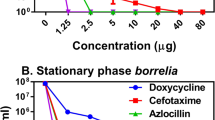Summary
The aim of this study was to investigate the morphological changes ofBorrelia burgdorferi associated with penicillin treatment. An isolate ofB. burgdorferi from an erythema migrans lesion was cultivated in BSK II medium and exposed to increasing concentrations (0.0625 mg/l-2 mg/l) of penicillin G for 5 days. Thein vitro minimal inhibitory concentration (MIC) was determined to be 0.5 mg/l by broth dilution method. The morphological structures of untreated spirochetes, as well as their characteristic ultrastructural changes when exposed to penicillin, were observed by electron microscopy. The following alterations were discovered: (i) Numerous outer sheath blebs at a penicillin concentration of 0.0625 mg/l. (ii) A characteristic irregular waveform of the borrelial cells and complete loss of the outer sheath at a penicillin concentration of 0.125 mg/l. (iii) The presence of “spheroplasts” at the same concentration. (iv) Structural changes of the protoplasmic cylinder complex which showed an irregular pattern at a penicillin concentration of 0.125 mg/l. (v) Disruption of the protoplasmic cylinder complex into several parts at penicillin concentrations of 0.25 mg/l and 0.5 mg/l. (vi) Severe cytolysis at penicillin concentrations of 1 mg/l and 2 mg/l.
Zusammenfassung
In der vorliegenden Studie berichten wir über morphologische Veränderungen vonBorrelia burgdorferi unter Einwirkung unterschiedlicher Penicillinkonzentrationen. Das untersuchteB. burgdorferi-Isolat wurde aus einer Hautprobe eines Erythema migrans in BSK II-Medium angezüchtet. Zur Bestimmung der minimalen Hemmkonzentration (MHK) wurden die Borrelien fünf Tage lang im Reihenverdünnungstest Penicillin G-Konzentrationen von 0,0625 mg/l bis 2 mg/l ausgesetzt. Die MHK wurde mit 0,5 mg/l ermittelt. In Abhängigkeit von den jeweiligen Penicillinkonzentrationen wurden folgende ultrastrukturelle Veränderungen der Borrelien beobachtet: (i) zahlreiche Ausstülpungen der äußeren Zellmembran bei einer Penicillinkonzentration von 0,0625 mg/l. (ii) Auftreten von „Sphäroplasten“ sowie von langgestreckten Borrelien, die ihre äußere Zellmembran vollständig verloren haben bei einer Penicillinkonzentration von 0,125 mg/l. (iii) Unregelmäßige scheckige Kontrastierung des Protoplasmazylinderkomplexes bei einer Penicillinkonzentration von 0,125 mg/l. (iv) Aufspaltung des Protoplasmazylinderkomplexes in mehrere Bruchstücke unter Penicillinkonzentrationen von 0,25 mg/l und 0,5 mg/l (v) Bakterienlyse bei Penicillinkonzentrationen von 1 mg/l und 2 mg/l.
Similar content being viewed by others
References
Preac-Mursic, V., Wilske, B., Schierz, G. EuropeanBorrelia burgdorferi isolated from humans and ticks — culture conditions and antibiotic susceptibility. Zbl. Bakt. Hyg. A 263 (1984) 112–118.
Preac-Mursic, V., Wilske, B., Schierz, G., Holmburger, M., Süß, E. In vitro andin vivo susceptibility ofBorrelia burgdorferi. Eur. J. Clin. Microbiol. 4 (1987) 424–426.
Johnson, R. C., Kodner, C., Russell, M. In vitro andin vivo susceptibility of the Lyme disease spirochete,Borrelia burgdorferi, to four antimicrobial agents. Antimicrob. Agents Chemother. 31 (1987) 164–167.
Johnson, S. E., Schmid, G. C., Feeley, J. C. Susceptibility of the Lyme disease spirochete to seven antimicrobial agents. Yale J. Biol. Med. 57 (1984) 99–103.
Luft, B. J., Volkman, D. J., Halperin, J. J., Dattwyler, R. J. New chemotherapeutic approaches in the treatment of Lyme borreliosis. In: Lyme Disease and Related Disorders. Ann. N. Y. Acad. Sci. 1988, vol. 539, pp. 352–436.
Johnson, R. C., Kodner, C. B., Jurkovich, P. J., Collins, J. J. Comparativein vitro andin vivo susceptibilities of the Lyme disease spirocheteBorrelia burgdorferi to cefuroxime and other antimicrobial agents. Antimicrob. Agents Chemother. 34 (1990) 2133–2136.
Weber, K., Marget, W. Critical remarks on antibiotic therapy. In:Weber, K., Burgdorfer, W. (eds.): Aspects of Lyme borreliosis. Springer-Verlag, Berlin Heidelberg 1993, pp. 352–357.
Dever, L. L., Jorgensen, J. H., Barbour, A. G. In vitro antimicrobial susceptibility testing ofBorrelia burgdorferi: a microdilution MIC method and time-kill studies. J. Clin. Microbiol. 30 (1992) 2692–2697.
Joseph, R., Holt, S. C., Canale-Parola, E. Peptidoglycan of free living anaerobic spirochetes. J. Bacteriol. 115 (1973) 426–435.
Barbour, A. G., Todd, W. J., Stoenner, H. G. Action of penicillin onBorrelia hermsii. Antimicrob. Agents Chemother. 19 (1982) 823–829.
Dever, L. L., Jorgensen, J. H., Barbour, A. G. In vitro activity of vancomycin against the spirocheteBorrelia burgdorferi. Antimicrob. Agents Chemother. 37 (1993) 1115–1121.
Barbour, A. G. Isolation and cultivation of Lyme disease spirochetes. Yale J. Biol. Med. 57 (1984) 521–525.
Johnson, R. C., Kodner, C. L., Russel, M. E. Vaccination of hamsters against experimental infection withBorrelia burgdorferi. Zbl. Bakt. Hyg. A 263 (1986) 45–48.
Adam, T., Graf, B., Neubert, U., Göbel, U. B. Detection and classification ofBorrelia burgdorferi by direct sequencing of 16S rRNA amplified after reverse transcription. Med. Microbiol. Lett. 1 (1992) 120–126.
Hovind-Hougen, K. Ultrastructure of spirochetes isolated fromIxodes ricinus andIxodes dammini. Yale J. Biol. Med. 57 (1984) 543–548.
Barbour, A. G., Hayes, S. F. Biology ofBorrelia species. Microbiol. Reviews 50 (1986) 381–400.
Hovind-Hougen, K., Asbrink, E. S., Stiernstedt, G., Steere, A. C., Hovmark, A. Ultrastructural differences among spirochetes isolated from patients with Lyme disease and related disorders, and fromIxodes ricinus. Zbl. Bakt. Hyg. A 263 (1986) 103–111.
Hayes, S. F., Burgdorfer, W. Ultrastructure ofBorrelia burgdorferi. In:Weber, K., Burgdorfer, W. (eds.): Aspects of Lyme borreliosis. Springer-Verlag, Berlin Heidelberg 1993, pp. 29–43.
Hayes, S. F., Burgdorfer, W., Barbour, A. G. Electron microscope characterization of cloned and uncloned strains ofBorrelia burgdorferi. In: Lyme disease and related disorders. Ann. N. Y. Acad. Sci. 1988, vol. 539, pp. 383–385.
Wensink, J., Witholt, B. Outer membrane vesicles released by normally growingEscherichia coli contain very little lipoprotein. Eur. J. Biochem. 116 (1981) 331–335.
Knox, K. W., Vesk, M., Work, E. Relation between excreted lipopolysaccharide complex and surface structures of a lysine-limited culture ofEscherichia coli. J. Bacteriol. 92 (1966) 1206–1217.
Swain, R. H. A. Electron microscopic studies of the morphology of pathogenic spirochetes. J. Path. Bact. Vol. LXIX (1955) 117–128.
Author information
Authors and Affiliations
Rights and permissions
About this article
Cite this article
Schaller, M., Neubert, U. Ultrastructure ofBorrelia burgdorferi after exposure to benzylpenicillin. Infection 22, 401–406 (1994). https://doi.org/10.1007/BF01715497
Received:
Accepted:
Issue Date:
DOI: https://doi.org/10.1007/BF01715497




